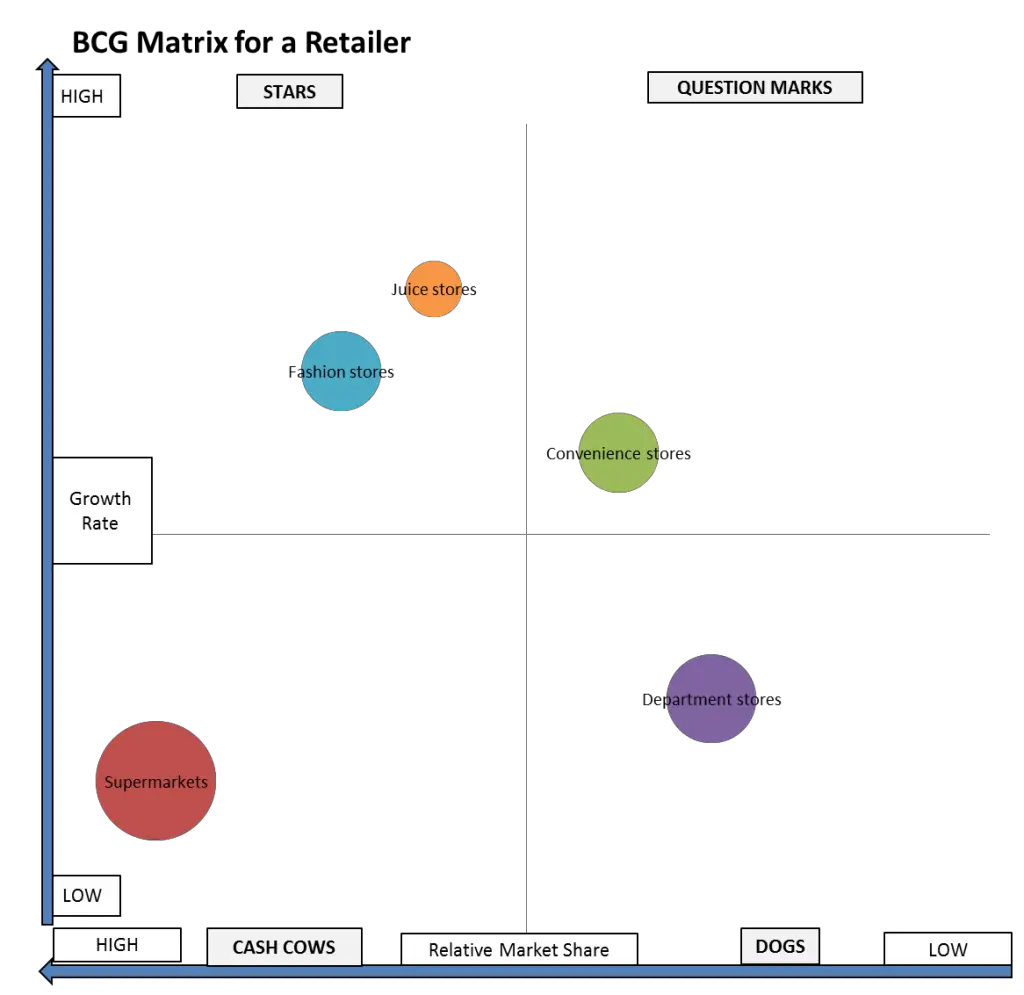BCG Matrix example
In this example, a retailer with five business portfolios is considered. Their five portfolios include:
- A chain of supermarkets
- A set of department stores
- A convenience store chain
- A range of specialist fashion stores and
- A chain of juice bars
As you can see from the BCG matrix, the firm has:
- One cash cow – their supermarket
- They have two stars – their fashion stores and their juice bars
- They have one dog – their department store chain
- And they have one question mark – their convenience stores
How are these portfolios classified?
The above BCG matrix was produced using the free Excel template available for download on this website. But the configurations of three dimensions for each portfolio are as follows:
- Supermarkets = high relative market share, low market growth rate, large revenue stream
- Fashion stores and juice bars = high relative market share, high market growth rate, medium (fashion) to small (juice) revenue streams
- Convenience stores = low relative market share, high growth rate, medium revenue stream
- Department stores = low relative market share, low growth rate, medium revenue stream
Please note that relative market share relates to the horizontal axis, growth rate relates to the vertical axis, and the revenue stream relates to the size of the circles.
What should they do?
Supermarket = cash cow
A cash cow has limited growth potential, but has substantial competitive advantages – meaning that it will generate surplus profits with minimal reinvestment needs. Therefore, the supermarket is providing virtually all of the reinvestment funds for the business.
Other than protecting their market share, and reinvesting in the business at a maintenance level, not many other strategic initiatives or decisions are required. It would be a poor use of resources to over-invest in this business in an attempt to achieve further growth.
Fashion stores and juice bars = stars
The firm has two business portfolios in the star quadrant. These two portfolios have the potential to become future cash cows. And given that the retailer currently only has one cash cow, it would be important to ensure that additional cash cows are created.
In order to focus upon the development of these two portfolios, the firm would need to further in invest in both of them – particularly the fashion stores – as it appears to be closer to becoming a cash cow (as opposed to the fashion stores) and is currently generating a larger revenue stream.
The juice bar portfolio, having a lower revenue stream, is likely to be a net user of cash. That means that some of the surplus profits from the supermarket business need to be reallocated to the juice bar chain in order to protect its position.
As we know, in a growth market, it is important to continue to expand the market coverage, to expand the product line, to build brand equity, to build retailer relationships, and engage in marketing tactics in order to hold and build market share.
Department stores = dog
Department stores are generally an older forms of retailing. As you can see, the market growth is minimal, primarily as consumers move to more specialist forms of retailing, as well as online shopping choices.
This retailer has a relatively low market share in the department store market – this poor competitive position combined with the lower market growth rate, means that the department store portfolio is classified as a dog.
Usually dogs make money for the retailer, but they would be making significantly less profits than the supermarket chain and there is little potential to grow this revenue stream. Therefore, the typical suggestion from the BCG matrix would be to divest (that is, sell off) the department store chain and to reinvest the proceeds into the potential cash cows of the fashion stores and the juice bars.
Convenience stores = question mark
As always with the BCG matrix guidance, the question Mark (or the problem child as is sometimes referred to) is the most difficult decision to make.
A do nothing approach would be a poor strategic choice. Left alone, a question mark eventually evolves into another dog. Currently, the question mark (of convenience stores) would be a net user of cash.
Therefore, the question is: “does the convenience store chain have sufficient competitive advantages to be able to effectively grow itself to become a major player in this market?”
If yes – then funds need to be reinvested into the chain in order to become a star and then a cash cow in the longer term. However, if this potential is doubtful or considered too expensive, then the most appropriate solution would be to divest this operation and reinvest the funds elsewhere in the business.

